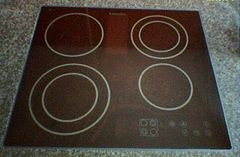| Revision as of 10:45, 30 July 2008 edit72.39.173.71 (talk)No edit summary← Previous edit | Revision as of 11:02, 30 July 2008 edit undo72.39.173.71 (talk)No edit summaryNext edit → | ||
| Line 19: | Line 19: | ||
| The same class of material is also used in ] dishes, which can be taken from the freezer directly to the oven with no risk of thermal shock. | The same class of material is also used in ] dishes, which can be taken from the freezer directly to the oven with no risk of thermal shock. | ||
| It's interesting to note that this technology isn't entirely new, as glass-ceramic ranges were first introduced in the ] using ] tops instead of the more durable material used today. These first generation smoothtops were problematic and required the use of certain cookware. | It's interesting to note that this technology isn't entirely new, as glass-ceramic ranges were first introduced in the ] using ] tops instead of the more durable material used today. These first generation smoothtops were problematic and required the use of certain cookware. | ||
| == Care and cleaning == | == Care and cleaning == | ||
Revision as of 11:02, 30 July 2008
Glass-ceramic materials share many properties with both glass and more traditional crystalline ceramics. It is formed as a glass, and then made to crystalize partly by heat treatment. Unlike sintered ceramics, glass-ceramics have no pores between crystals.
While materials such as "vaseline" glass are also glass-ceramics, the term mainly refers to a mix of lithium-, silicon-, and aluminium-oxides which yields an array of materials with interesting thermomechanical properties. The most commercially important of these have the distinction of being impervious to thermal shock. Originally developed for use in the mirrors and mirror mounts of astronomical telescopes, these materials have become known and entered the domestic market through its use in glass-ceramic cooktops, as well as cookware and bakeware.

The crystalline component of thermal glass-ceramics, beta spodumene, has a negative coefficient of thermal expansion, which contrasts with the positive coefficient of the glass. Adjusting the proportion of these two materials offers a wide range of possible coefficients in the finished composite.
When an interface between materials will be subject to thermal fatigue, glass-ceramics can be adjusted to match the coefficient of the material they will be bonded to. At a certain point, generally between 70% and 78% crystallinity, the two coefficients balance such that the glass-ceramic as a whole has a thermal expansion coefficient that is very close to zero.
Glass-ceramic is a mechanically very strong material and can sustain repeated and quick temperature changes up to 800–1000 °C. At the same time, it has a very low heat conduction coefficient and can be made nearly transparent (15–20% loss in a typical cooktop) for radiation in the infrared wavelengths. It is not, however, totally unbreakable. There have been instances where users reported damage to their cooktops when the surface was struck with a hard or blunt object(such as a can falling from above, or other heavy items).
Today, there are two major types of electrical stoves with cooktops made of glass-ceramic:
- A glass-ceramic stove uses radiant heating coils or infrared halogen lamps as the heating elements. The surface of the glass-ceramic cooktop above the burner heats up, but the adjacent surface remains cool because of the low heat conduction coefficient of the material.
- An induction stove heats a metal pot's bottom directly through electromagnetic induction.
Some well-known brands of glass-ceramics are Ceran (cooktops), Eurokera (cooktop, stoves and fireplaces), Zerodur (telescope mirrors), or Macor. German manufacturer Schott introduced Zerodur in 1968, Ceran followed in 1971. Nippon Electric Glass of Japan is another worldwide manufacturer of glass ceramics, whose related products in this area include Firelite and Neoceram fire-rated glass.
The same class of material is also used in Corningware dishes, which can be taken from the freezer directly to the oven with no risk of thermal shock.
It's interesting to note that this technology isn't entirely new, as glass-ceramic ranges were first introduced in the 1970's using Corningware tops instead of the more durable material used today. These first generation smoothtops were problematic and required the use of certain cookware.
Care and cleaning
Glass-ceramic cooktops can be scratched very easily, so care must be taken not to slide the cooking pans over the surface. Food with a high sugar content (such as jam) should never be allowed to dry on the surface if it spills, otherwise damage will occur. Cleaning is best carried out by using a soft cloth along with a special glass-ceramic cleaner that applies a thin protective film on the glass.
Categories: